29 sierpnia 2019 o godz. 19 w Centrum Dokumentacyjnym Robót Przymusowych w okresie nazizmu, przy ulicy Britzer 5 w Berlinie-Schoeneweide, odbędzie się uroczyste otwarcie wystawy „Historia przeżycia i Zagłady. Holokaust i praca przymusowa na terenie Galicji“. Bazuje ona na wystawie Holokaust w Galicyjskim Okręgu Naftowym, którą stworzyliśmy we współpracy z izraelską organizacją DBO (Uratowanych z Drohobycza i Borysławia i ich Potomków), a pokazywaliśmy już dwadzieścia razy w czterech różnych krajach.
Wystawa została poszerzona na potrzeby Centrum Dokumentacyjnego Robót Przymusowych o tematykę pracy przymusowej Żydów na terenie Galicji oraz o krótkie biografie sprawców, ofiar i ratujących Żydów.
Wystawę, którą oglądać można do końca stycznia 2020, wzbogaci program towarzyszący.
W imieniu pana Klausa Hasbron-Blume- kuratora wystawy, zapraszam na wernisaż i do uczestnictwa w spotkaniach
A Story of Destruction and Survival
The Holocaust in the Galician Oil Belt
Seite 9 von 12
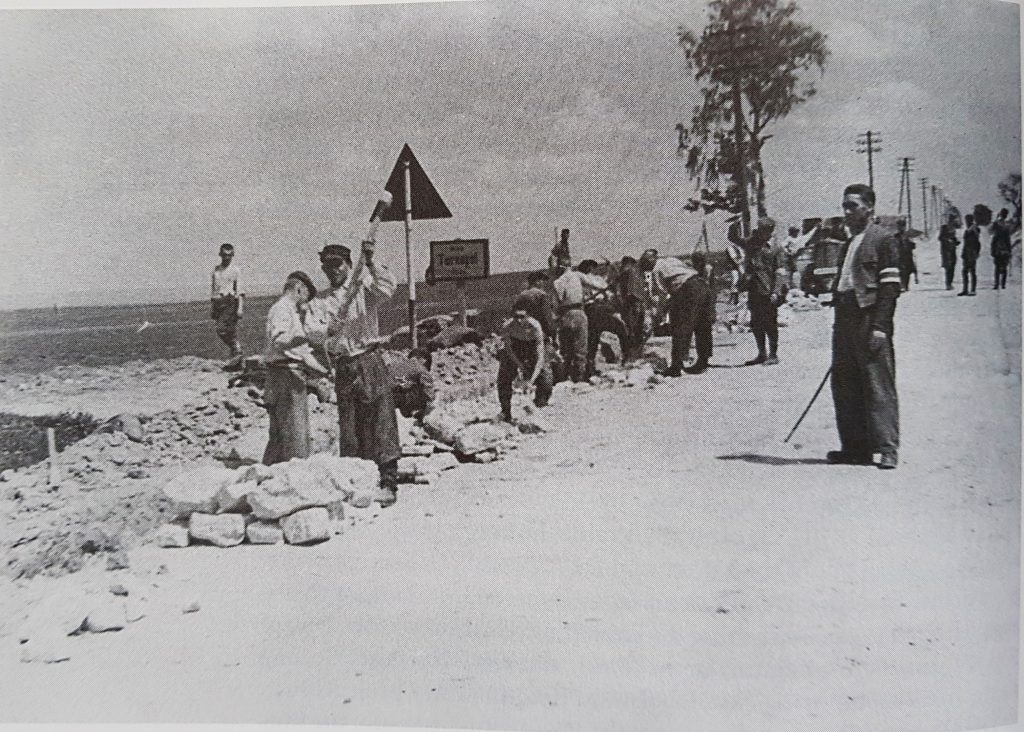
Zwangsarbeit an der Durchgangsstraße IV. Propagandafoto aus dem „Katzmann-Bericht“
[DE] Am 29. August wird diese Ausstellung in Berlin mit einer Vernissage eröffnet. Sie basiert auf der Ausstellung „Eine Geschichte von Vernichtung und Überleben“, die in einem multinationalen Projekt gemeinsam entwickelt wurde mit DBO (Organisation der Überlebenden und Nachkommen aus Drohobycz, Boryslaw und Umgebung). Die Ausstellung im Dokumentationszentrum wurde erweitert, vor allem um Informationstische zur Zwangsarbeit von Juden in Galizien.
read more / Czytaj więcej >
Unser besonderer Dank gilt der Leiterin des Dokumentationszentrums, Frau Dr. Christine Glauning, und Roland Borchers, mit dem wir in der Vorbereitung hervorragend zusammenarbeiten konnten.
Die Ausstellung bietet ein interessantes Begleitprogramm und wird bis Ende Januar 2020 in Berlin gezeigt werden. Weiterlesen
Text / Tekst in EN / DE / PL
[EN] Eberhard Helmrich was assigned in 1941 as chief economic officer for the Drohobycz area in Galicia. He protected Poles from persecution and saved the lives of many Jews from extermination. Yad Vashem recognized him as a Righteous Among the Nations.
In the same house with him lived his Polish driver, Jan Wojnar, with his family. Jan Wojnar was not only informed about Helmrich’s rescue activities, but also took an active part in them. He drove Jews to the border at his own risk so that they could flee. He undertook these trips accompanied by Helmrich or alone.
read more / Czytaj więcej > Weiterlesen
[DE) Einladung zur Ausstellungseröffnung „Eine Geschichte von Vernichtung und Überleben“ – Der Holocaust im galizischen Erdölrevier
Ort: Fritz-Bauer-Gesamtschule, Siegstr. 123, 53757 Sankt Augustin
Datum: Mittwoch, 30. Januar 2019, 17:00
Anmerkung: Bei den Projektträgern wurde DBO (Drohobycz BoryslawOrganisation) aus Israel versehentlich nicht aufgeführt – ohne sie hätte es aber dieses Projekt und die Ausstellung nie gegeben
[EN] Invitation to the exhibition opening
„A Story of Destruction and Survival“ – The Holocaust in the Galician Oil Belt
Location: Fritz Bauer Gesamtschule, Siegstr. 123, 53757 Sankt Augustin
Date: Wednesday, 30. January 2019, 17:00
Note: DBO (Drohobycz Boryslaw Organisation) from Israel was inadvertently not listed with the project sponsors – but without them this project and the exhibition would never have taken place.
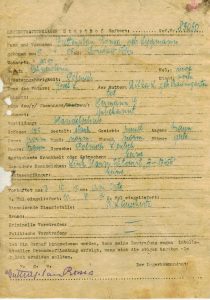
Häftlingskarte Ronja Guttenplan, KZ Stutthof
Text / Tekst in DE / EN / PL
[DE] In Münster fand ein Prozess statt gegen einen früheren SS-Wachmann des Konzentrationslagers Stutthof (etwa 50 km entfernt von Danzig); die Regionalschau Münster berichtete darüber. (WDR-Münster über das KZ Stutthof)
read more / Czytaj więcej >
In unserer Ausstellung über den Holocaust im galizischen Erdölrevier dokumentieren wir vor allem das Schicksal der jüdischen Familie Lippman. Ronya (Ronja) Guttenplan war die Tante des Überlebenden Prof. Józef Lipman. Als die Nazi-Besatzung angesichts der heranrückenden Roten Armee die Erdölstadt Boryslaw aufgab, löste man das Zwangsarbeitslager für Juden auf und brachte die noch lebenden arbeitsfähigen Juden in das KZ Krakau-Plaszów. Von dort wurde Ronya Guttenplan in das KZ Auschwitz transportiert, wo sie am 8.8.1944 unter der Häftlingsnummer A_17456 registriert wurde. Am 10.9.1944 wurde sie dann in das KZ Stutthof überstellt (Häftlingsnummer #85050). Dort kam sie um: ob durch Entkräftung, Hunger, Krankheit, Misshandlung oder Spritze ins Herz lässt sich nicht mit Sicherheit sagen.
Der Prozess wurde jetzt wegen des Gesundheitszustandes des Angeklagten vorzeitig beendet (WDR-Münster über das Prozessende). Trotzdem war es in jedem Fall gut, dass durch diesen Prozess noch einmal an die Ermordung der Juden in diesem KZ erinnert wurde. Für uns verbindet sich dieses grausige Geschehen auch mit dem Bild von Ronya Guttenplan.
[EN] A trial against a former SS guard of the Stutthof concentration camp (about 50 km away from Danzig) took place in Münster; the Regionalschau Münster reported on it.
In our exhibition on the Holocaust in the Galician oil district, we document above all the fate of the Jewish Lippman family. Ronya Guttenplan was the aunt of the survivor Prof. Józef Lipman. When the Nazi occupation abandoned the oil town of Boryslaw in the face of the approaching Red Army, the forced labor camp for Jews was dissolved and the Jews still alive and able to work were brought to the Krakow-Plaszów concentration camp. From there, Ronya Guttenplan was transported to the Auschwitz concentration camp, where she was registered on 8 August 1944 under prisoner number A_17456. On September 10, 1944, she was transferred to the Stutthof concentration camp (prisoner number #85050). There she was killed: whether by
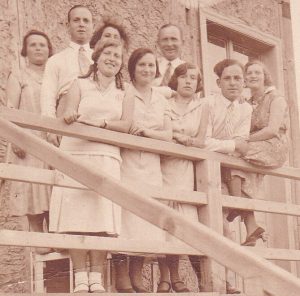
Familienfoto vor 1939; Ronja Guttenplan ganz links
exhaustion, hunger, illness, abuse or injection into the heart cannot be said with certainty. In any case, it is good that this trial once again reminds us of the murder of the Jews in this concentration camp. For us, this horrible event is also connected with the image of Ronya Guttenplan.
[PL] Obecnie w Münsterze toczy się proces przeciwko byłemu strażnikowi SS z obozu koncentracyjnego Stutthof (ok. 50 km od Gdańska), o którym informuje dziennik regionalny z Münsteru.
Na wystawie poświęconej Holokaustowi w galicyjskim okręgu naftowym dokumentujemy przede wszystkim losy żydowskiej rodziny Lippmanów. Ronja Guttenplan była ciotką ocalałego prof.Józefa Lipmana. Niemcy uciekając przed zbliżającą się Armią Czerwoną, tuż przed opuszczeniem miasta naftowego Borysław, likwidują obóz pracy przymusowej dla Żydów, a Żydów wciąż żyjących i zdolnych do pracy przewożą do obozu koncentracyjnego Kraków-Plaszów. Stamtąd przewożą Ronję Guttenplan do obozu koncentracyjnego Auschwitz, gdzie 8 sierpnia 1944 r. została zarejestrowana pod numerem więźnia A_17456. Następnie 10.9.1944 r. przenoszą ją do obozu koncentracyjnego Stutthof (numer więźniai #8505050) gdzie zmarła: czy to przez wyczerpanie, głód, chorobę, maltretowanie czy zastrzyki do serca, tego nie można z całą pewnością stwierdzić. W każdym razie dobrze się stało, że ten proces po raz kolejny przypomina nam o zabójstwie Żydów w tym obozie koncentracyjnym. Dla nas to makabryczne wydarzenie jest również związane z obrazem Ronji Guttenplan.
[EN] From May 2015 to the end of 2018, the exhibition has already been shown 18 times in four different countries (PL, IL, UA, D): we are proud of it, but do not want to rest on our laurels. Unfortunately, the wave of populism, nationalism and anti-Semitism gives no reason for this. We thank our project partners, especially DBO (Drohobycz, Boryslaw and Vicinity Organisation from Israel) for their cooperation and support.
[DE] Von Mai 2015 bis Ende 2018 wurde die Ausstellung bereits 18-mal in vier verschiedenen Ländern (PL, IL, UA, D) gezeigt: wir sind stolz darauf, aber wollen uns nicht auf unseren Lorbeeren ausruhen. Dazu gibt leider die Welle des Populismus, Nationalismus und Antisemitismus keinen Anlass. Wir danken unseren Projektpartnern, vor allem DBO (Drohobycz, Boryslaw and Vicinity Organisation aus Israel), für die Zusammenarbeit und Unterstützung
[PL] Od maja 2015 roku do końca 2018 roku wystawa była już 18 razy pokazywana w czterech różnych krajach (PL, IL, UA, D): jesteśmy z niej dumni, ale nie chcemy spocząć na laurach. Niestety, fala populizmu, nacjonalizmu i antysemityzmu nie daje do tego powodu. Dziękujemy naszym partnerom projektu, a w szczególności DBO (Drohobycz, Borysław i Organizacja Wicypialnia z Izraela) za współpracę i wsparcie.
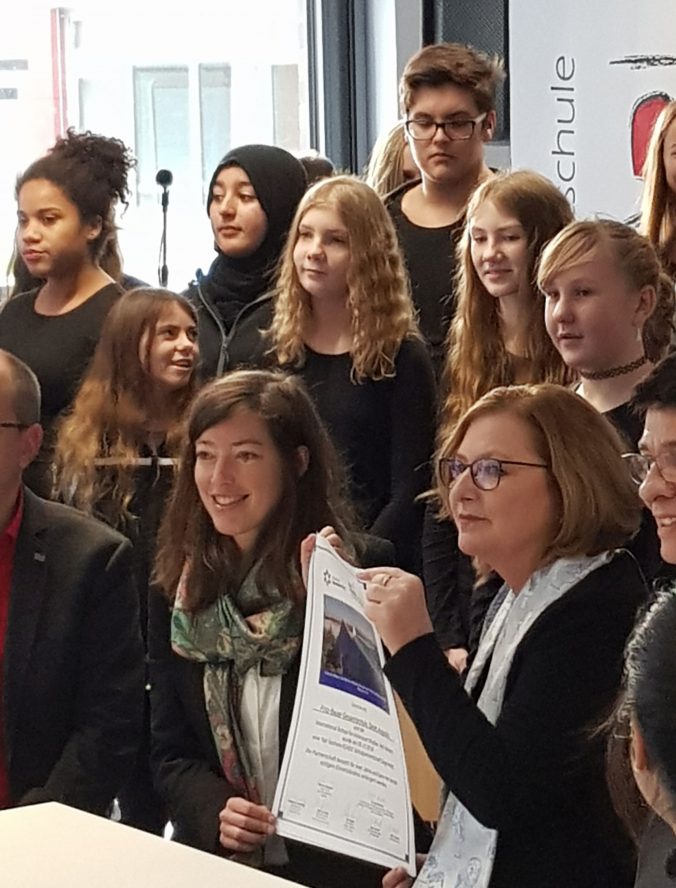
Partnerschaft / Partnership Fritz-Bauer-Gesamtschule & Yad Vashem
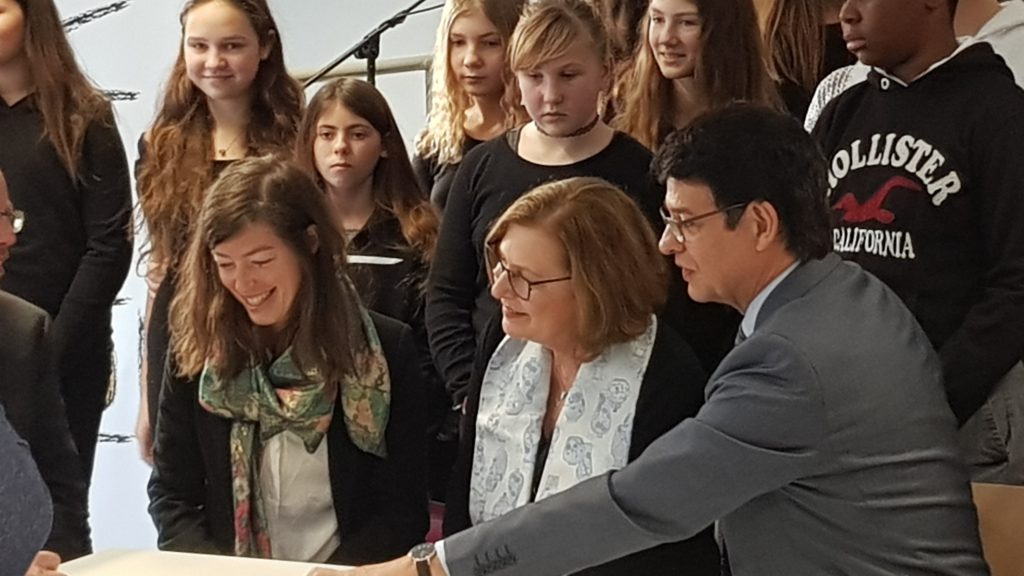
Myriam Matalon (Yad Vashem), Stephani Overhage (Schulleiterin / school principal), Klaus Schumacher (Bürgermeister / mayor) signing the contract
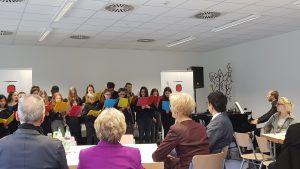
Schulchor / school choir: Hey (Andreas Bourani)
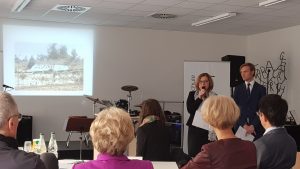
Schulleiterin / Headmistress Stephani Overhage & ihr Stellvertreter / her deputy Patrick Werneburg
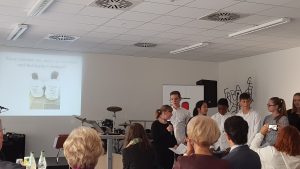
Schüler berichten über ihre Erfahrungen in Israel und warum sie für diese Kooperation sind
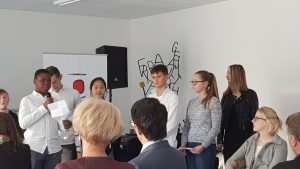
Students share their experiences in Israel and why they consider the partnership important
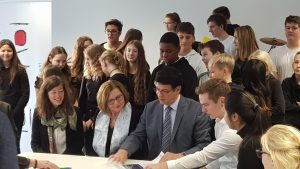
At the signing of the contract
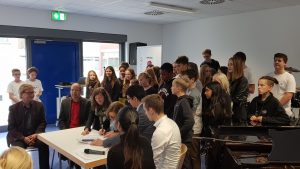
Bei der Vertragsunterzeichnung
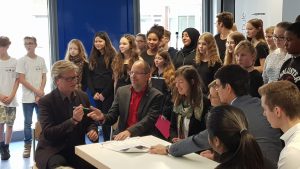
Schulfachlicher Dezernent Martin Nolte, Vertreter der Eltern und Schülerverteter unterzeichnen ebenfalls
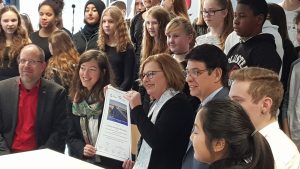
Die Kooperationsurkunde / certificate of cooperation
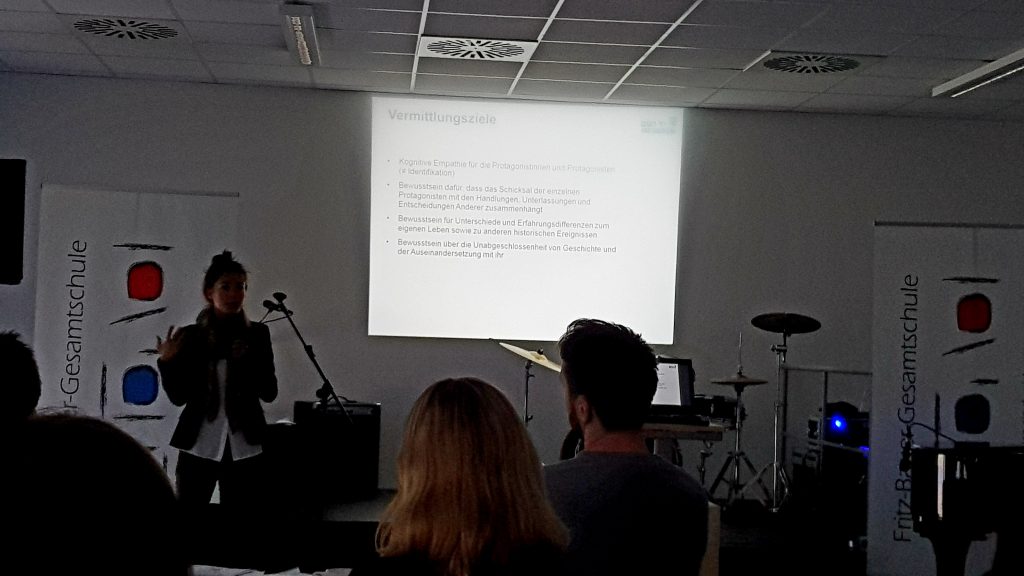
Myriam Matalon (Yad Vashem) bei ihrem Vortrag über das pädagogische Konzept / explaining the pedagogical concept of the International School for Holocaust Studies
[DE] Am Mittwoch, dem 5. Dezember, fand die Auftaktveranstaltung zur Kooperation der Fritz-Bauer-Gesamtschule in St. Augustin bei Bonn mit dem German Desk der International School for Holocaust Studies von Yad Vashem statt. Die Fritz-Bauer-Gesamtschule hat sich – ihrem Namensgeber entsprechend – ein Schulprogramm gegeben, das sich dem Kampf gegen Rassismus und Antisemitismus verpflichtet und wichtige Elemente der Holocaust-Didaktik enthält. Seit 2014 besteht eine Schulpartnerschaft mit der Hayovel Junior High School in Mewasseret Zion in Israel. Auf dieser Veranstaltung wurde feierlich die Kooperation unterzeichnet: Myriam Matalon unterschrieb für die International School von Yad Vashem; auf deutscher Seite unterschrieben u.a. die Schulleitung, Eltern- und Schülervertreter, der Bürgermeister der Stadt Sankt Augustin. Dies ist die vierzehnte Kooperation mit einer deutschen Schule. Am Nachmittag stellte Myriam Matalon sehr eindrücklich das pädagogische Konzept vor, das Yad Vashem entwickelt hat, um Schüler heute altersgemäß und ihrem kulturellen Hintergrund entsprechend anzusprechen.
Ende Januar 2019 wird unsere Ausstellung über den Holocaust in Galizien drei Monate lang in der Schule gezeigt und im Unterricht intensiv behandelt werden.
[EN] On Wednesday, 5 December, the opening event of the cooperation between the Fritz Bauer Comprehensive School in St. Augustin near Bonn and the German Desk of the International School for Holocaust Studies of Yad Vashem took place. The Fritz Bauer Integrated Comprehensive School – according to its eponym – has given itself a school programme which is committed to the fight against racism and anti-Semitism and contains important elements of Holocaust didactics. Since 2014 there has been a school partnership with the Hayovel Junior High School in Mewasseret Zion in Israel. The cooperation was solemnly signed at this event: Myriam Matalon signed for Yad Vashem’s International School; on the German side, the school management, parents‘ and students‘ representatives, the mayor of the city of Sankt Augustin, and others, signed. This is the fourteenth cooperation with a German school.
In the afternoon, Myriam Matalon presented very impressively the educational concept that Yad Vashem has developed to address students today according to their age and cultural background.
At the end of January 2019, our exhibition on the Holocaust in Galicia will be shown at this school for three months and intensively discussed in class.
[PL] W środę, 5 grudnia, odbyło się uroczyste rozpoczęcie współpracy pomiędzy Gesamtschule im. Fritza Bauera w St. Augustin koło Bonn a German Desc International School for Holocaust Studies z Yad Vashem. Fritz-Bauer-Gesamtschule przyjęła do realizacji – w myśl ideałów swojego patrona – program szkolny, który propaguje walkę z rasizmem i antysemityzmem i zawiera ważne elementy dydaktyki Holokaustu. Od 2014 r. istnieje partnerstwo szkół z Hayovel Junior High School w Mewasseret Zion w Izraelu. Współpracę potwierdzono uroczyście podczas tego wydarzenia podpisami: Myriam Matalon ze strony International Scool z Yad Vashem, a ze strony niemieckiej między innymi: zarząd szkoły, przedstawiciele rodziców i uczniów, burmistrz miasta Sankt Augustin. Jest to czternasta już współpraca z niemiecką szkołą. Po południu Myriam Matalon przedstawiła koncepcję edukacyjną, którą Yad Vashem opracował z myślą o dzisiejszych uczniach w zależności od ich wieku i pochodzenia kulturowego.
Pod koniec stycznia 2019 r. nasza wystawa na temat Holokaustu w Galicji będzie pokazywana w szkole przez trzy miesiące i intensywnie dyskutowana na zajęciach szkolnych.
[DE] Unser Teammitarbeiter, Fotograf und Grafik-Designer, Christian Herrmann, hat ein neues Fotobuch herausgegeben: „In schwindendem Licht. Spuren jüdischen Lebens im Osten Europas.“ In der Online-Ausgabe des Nachrichtenmagazins der Spiegel erschien eine begeisterte Besprechung.
[EN] Our team member, photographer and graphic designer Christian Herrmann, has published a new photo book: „In fading light. Traces of Jewish life in Eastern Europe“. An enthusiastic review appeared in the online edition of the news magazine Der Spiegel.
bloodlands-fotos-der-spuren-juedischen-lebens-in-osteuropa-a-1229912.html
[Deutsch]
Die Webseite der Stiftung Kreisau berichtet über unsere Ausstellung zum Holocaust im Galizischen Erdölrevier, die bis 20.Mai dort zu sehen ist. Die Fotos sind während einer Tagung zur Gedenkstättenarbeit entstanden – die Rollups standen dort im Konferenzraum. Mittlerweile ist die Ausstellung umgezogen in das repräsentative Schloss
Deutsche Webseite der Stiftung Kreisau
[Polski]
Wystawa „Przywracać Pamięć. Holokaust na terenie Galicji” do maja w Krzyżowej
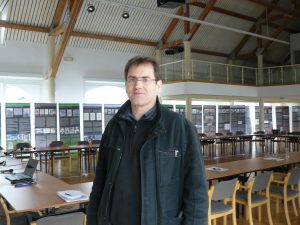
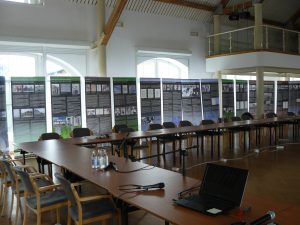
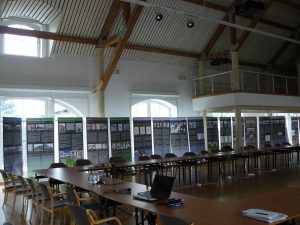
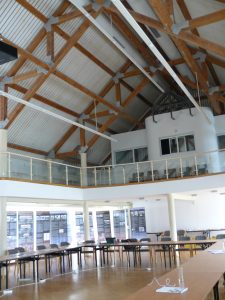
Post by Wiesia Jurasz:
[Polski]
Od wczoraj, 22 marca ” do połowy maja 2018 będzie można oglądać wystawę „Holokaust na terenie Galicji” w Miejscu Pamięci Fundacji „ Krzyżowa” dla Porozumienia Europejskiego w Krzyżowej/Kreisau. Jest ona częścią międzynarodowego projektu Akcji Znaku Pokuty z Niemiec , Organizacji Drohobycz-Borysław i Potomkowie z Izraela i Fundacji Bente Kahan z Wrocławia, którą po raz pierwszy zaprezentowano publiczności w maju 2015 w Synagodze Pod Białym Bocianem. Otwarcie wystawy zbiegło się z początkiem Seminarium Wschodnio- i Zachodnioeuropejskich Miejsc Pamięci, na które do Krzyżowej przybyli historycy i współpracownicy miejsc pamięci, muzeów, organizacji praw człowieka lub osoby zajmujące się projektami dotyczącymi świadków historii.
Wystawa składa się z 29 polsko-angielskich rollupów o poruszającej treści, ilustrowanych wieloma autentycznymi, archiwalnymi zdjęciami. Przedstawia Holokaust na terenie Borysławsko-Drohobyckiego Zagłębia Naftowego. Opisuje losy mieszkających tam rodzin żydowskich, skupiając się na historii rodziny Józefa Lipmana (żyjącego świadka historii). Przypomina również postaci ludzi: Niemców, Polaków i Ukraińców, którzy ratując Żydów, narażali życie swoje i swoich rodzin – bohaterów odznaczonych medalem Sprawiedliwy wśród Narodów Świata.
[Deutsch]
Von gestern, dem 22. März, bis Mitte Mai 2018 wird die Ausstellung „Der Holocaust in Galizien“ in der Gedenkstätte der Stiftung Kreisau für gegenseitiges Verständnis in Europa in Krzyżowa/Kreisau zu sehen sein. Es ist Teil des internationalen Projekts der Aktion Sühnezeichen (ASF) aus Deutschland, der Drohobycz-Borysław Organisation der Überlebenden und ihrer Nachkommen (DBO) aus Israel und der Bente Kahan Stiftung (FBK) aus Breslau/Wrocław in Polen. Die Ausstellung wurde im Mai 2015 in der Synagoge „Zum Weißen Storch“ in Breslau erstmals der Öffentlichkeit vorgestellt. Die Eröffnung der Ausstellung in Kreisau fiel mit dem Beginn des Seminars zur ost- und westeuropäischen Gedenkstättenarbeit zusammen, an dem Historiker und Mitarbeiter von Gedenkstätten, Museen, Menschenrechtsorganisationen oder Personen, die an Zeitzeugenprojekten beteiligt sind, teilnehmen.
Die Ausstellung besteht aus 29 polnisch-englischen Rollups mit bewegenden Inhalten, illustriert mit vielen authentischen Archivfotos. Sie zeigt den Holocaust im Galizischen Ölrevier. Sie beschreibt das Schicksal der dort lebenden jüdischen Familien, vor allem die Geschichte der Familie von Prof. Dr. Józef Lipman, einem noch lebenden Zeitzeugen. Sie erinnert auch an Menschen – Deutsche, Polen und Ukrainer -, die ihr Leben und das Leben ihrer Familien riskierten, indem sie Juden retteten – Helden, die als Gerechte unter den Völkern geehrt werden.
[English]
From yesterday, March 22, until mid-May 2018, an exhibition entitled „The Holocaust in Galicia“ in the Memorial Site of the Krzyżowa Foundation for Mutual Understanding in Europe in Krzyżowa/Kreisau will be on display. It is a part of the international project „Action of the Reconciliation Mark“ from Germany, the Drohobych-Borysław Organization and descendants from Israel and the Bente Kahan Foundation from Wrocław, which was presented to the public for the first time in May 2015 in the White Stork Synagogue. The opening of the exhibition coincided with the beginning of the Seminar of East and West European Memorials, which was attended by historians and collaborators of memorial sites, museums, human rights organizations or people involved in history witness projects.
The exhibition consists of 29 Polish-English rollups with moving content, illustrated with many authentic, archival photographs. It presents the Holocaust in the Borysław-Drohobych Oil Belt. It describes the fate of Jewish families living there, focusing on the history of the family of Józef Lipman (a living witness of history). It also reminds people: Germans, Poles and Ukrainians, who risked their lives and the lives of their families by saving Jews – the heroes honored as Righteous Among the Nations.
© 2026 A Story of Destruction and Survival
Theme von Anders Norén — Hoch ↑